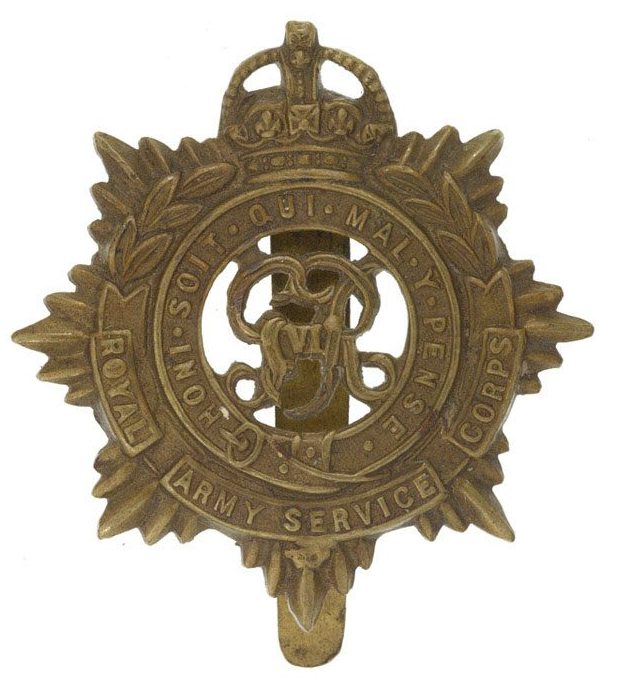Personal Details
Born: 7 February 1880 in Whitchurch, Shropshire and baptised 4 April 1880 at the Wesleyan Methodist Chapel, Whitchurch.
Family: He was the eldest of at least five children born to Benjamin Blyth Powell, a draper and his wife Martha, nee Jones. He married Mary Ellen Cheshire on 24 February 1903 in Whitchurch. The couple had four children, Richard Roland, Frank, William Cyril and Dorris Mary.
Residence: In 1881 his family were living in Talbot Street, however in 1891 their address was Sandford Bridge, Newall, Cheshire. In 1911 and now married he was living at 11 Farm Lane, Fulham; this was the address stated on his Attestation in 1913. By 1939 the family were living at 21 Percy Street, Ilford, Essex. This continued to be his home until his death in 1953.
Employment: In 1911 he was a coachman and in 1913 a motor driver. In 1939 his occupation was a bus driver.
Died: 5 November 1953 at Oldchurch Hospital, Romford, Essex, aged 73.
Military Details
Regiment: Royal Army Service Corps
Rank: Private
Service Number: CMT/1407
Date of Enlistment: 22 April 1913
Date of Discharge: 26 April 1916
Reason for Discharge: Termination of Engagement
Richard was awarded the Campaign Medals (1914 Star, British War medal and Victory medal)

The 1914 Star (also known as 'Pip') was authorised under Special Army Order no. 350 in November 1917 and by an Admiralty Fleet Order in 1918, for award to officers and men of the British and Indian Expeditionary Forces who served in France or Belgium between 5 August and midnight of 22–23 November 1914. The former date is the day after Britain's declaration of war against the Central Powers, and the closing date marks the end of the First Battle of Ypres.
The 1914–15 Star (also known as 'Pip') was instituted in December 1918 and was awarded to officers and men of British and Imperial forces who served against the Central European Powers in any theatre of the Great War between 5 August 1914 and 31 December 1915. The period of eligibility was prior to the introduction of the Military Service Act 1916, which instituted conscription in Britain.
The British War Medal (also known as 'Squeak') was a silver or bronze medal awarded to officers and men of the British and Imperial Forces who either entered a theatre of war or entered service overseas between 5th August 1914 and 11th November 1918 inclusive. This was later extended to services in Russia, Siberia and some other areas in 1919 and 1920. Approximately 6.5 million British War Medals were issued. Approximately 6.4 million of these were the silver versions of this medal. Around 110,000 of a bronze version were issued mainly to Chinese, Maltese and Indian Labour Corps. The front (obv or obverse) of the medal depicts the head of George V. The recipient's service number, rank, name and unit was impressed on the rim.
The Allied Victory Medal (also known as 'Wilfred') was issued by each of the allies. It was decided that each of the allies should each issue their own bronze victory medal with a similar design, similar equivalent wording and identical ribbon. The British medal was designed by W. McMillan. The front depicts a winged classical figure representing victory. Approximately 5.7 million victory medals were issued. Interestingly, eligibility for this medal was more restrictive and not everyone who received the British War Medal ('Squeak') also received the Victory Medal ('Wilfred'). However, in general, all recipients of 'Wilfred' also received 'Squeak' and all recipients of The 1914 Star or The 1914/1915 Star (also known as 'Pip') also received both 'Squeak' and 'Wilfred'. The recipient's service number, rank, name and unit was impressed on the rim.


This is totally true and by coincidence that on 21st/22nd April 2020 I found the family tree my father Richard Powell had formulated some years back before he passed away. I was drawn to the name of my Great Grandfather Richard Roland Powell and his father Bennamin Blyth Powell. To the exact day 107 years after my Great Grandfather enlisted in to the Army I tap in his name on Google and find this piece of my family’s history. I knew he had served in the Army 1st World War and upon leaving service started to be involved in transport bus operations and set up a bus company pre London Transport referred to as a Pirate Operator. His company was taken over and he worked right up to the age of approx 70 driving buses in East London. My Grandfather also served in the forces joining the Royal Airforce in the 2nd WW serving as a Warrant Officer.
So glad we got it right Adam. The Wesleyan chapel where he was baptised is the building that Whitchurch Museum & Archives is housed in !
If you have any more information regarding Richard and/or a photograph we would be extremely interested.
Yes of course I’ll ask my mother to see If she can locate any photos that my father had of him. When reading some of the names It looked like his brothers and possibly cousins had enlisted as well. With some time on my hands at the moment I was trying pick up the family tree where my father left off. Apparently I’m the last Powell on my Great Grandfather Richard Roland side and I was trying to see if his siblings had children. At some point in the future I would like to visit Whitchurch and your museum But I will come back to as soon as possible on anything I can find. Thank you so much